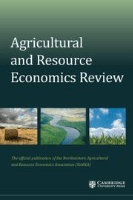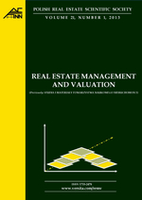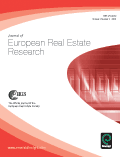
Aestimum
Scope & Guideline
Connecting Ecology, Economics, and Urban Studies for Impact
Introduction
Aims and Scopes
- Real Estate Valuation Methodologies:
The journal emphasizes various methodologies for real estate valuation, including traditional methods like Market Comparison Approach (MCA) and emerging techniques such as Automated Valuation Models (AVM) and machine learning applications. - Sustainability and Environmental Impact:
Aestimum explores the implications of sustainability on real estate, assessing how ecological factors influence valuation and land use, particularly in urban and agricultural settings. - Legal and Regulatory Frameworks:
The journal regularly reviews jurisprudential developments and their impact on valuation practices, highlighting the importance of legal standards in the appraisal process. - Spatial and Geographic Analysis:
Aestimum incorporates geographic information systems (GIS) and spatial regression analyses to understand land value determinants, particularly in relation to public assets and agricultural land. - Interdisciplinary Approaches:
The journal encourages research that integrates various disciplines, such as economics, law, urban planning, and environmental science, to provide comprehensive insights into valuation issues.
Trending and Emerging
- Machine Learning and Predictive Modeling in Valuation:
There is a notable increase in studies employing machine learning techniques for housing price prediction and valuation, highlighting the integration of technology in real estate analytics. - Sustainability and Urban Development:
Emerging themes focus on the intersection of sustainability and urban development, particularly how ecological factors and urban policies influence real estate markets and valuations. - Impact of Covid-19 on Real Estate Valuation:
Research examining the effects of the Covid-19 pandemic on real estate valuation and market dynamics has gained prominence, reflecting the need for adaptive methodologies in uncertain times. - Spatial Analysis in Agricultural Valuation:
A growing interest in spatial analysis, particularly regarding farmland valuation and price determinants, indicates a shift towards data-driven approaches in understanding agricultural markets. - Cultural and Creative Economic Indices:
The exploration of cultural and creative economic indices suggests an emerging trend towards assessing the impact of cultural factors on urban valuation and development.
Declining or Waning
- Traditional Market Analysis Techniques:
There appears to be a waning emphasis on traditional market analysis methods in favor of more advanced statistical and computational techniques, such as machine learning and big data analytics. - General Case Law Reviews:
The frequency of general case law reviews has decreased, suggesting a shift towards more specialized legal analyses that directly connect legal frameworks to valuation methodologies. - Studies on Economic Contributions of Non-Timber Products:
Research focusing on non-timber forest products and their economic contributions has diminished, indicating a potential narrowing of focus towards more pressing urban and real estate issues.
Similar Journals

Ecological Indicators
Leading the way in ecological research and environmental solutions.Ecological Indicators, published by Elsevier, is a prestigious journal dedicated to advancing the fields of ecology and environmental science. With an impressive impact factor and ranked in the Q1 quartile for both Ecology and Decision Sciences categories, the journal serves as a vital resource for researchers and professionals aiming to apply ecological knowledge to real-world problems. The journal covers a broad scope of topics within ecological indicators, aiming to provide comprehensive insights into biodiversity, ecosystem health, and sustainability metrics. Founded in 2001 and continuing through 2024, Ecological Indicators has established itself as a leader in disseminating significant research and innovative findings. The journal's standing is reflected in its remarkable Scopus ranks, placing it among the top percentile in its respective categories. Authors are encouraged to submit their work to share vital findings with an engaged audience of researchers, professionals, and dedicated students, ensuring the continued relevance and impact of ecological research on global environmental policies and practices.

International Journal of Economic Sciences
Empowering scholars through open access to economic insights.International Journal of Economic Sciences is a premier academic publication dedicated to advancing the field of economics through rigorous research and scholarly discourse. Published by the EUROPEAN RESEARCH CENTER, this journal serves as a vital platform for economists, researchers, and practitioners to share innovative findings and theoretical advancements. With a focus on a wide range of economic topics, including but not limited to macroeconomics, microeconomics, and applied economics, the journal endeavors to foster a deeper understanding of economic phenomena in both local and global contexts. As an open access journal, it ensures that valuable research is accessible to a broad audience, promoting knowledge dissemination and collaboration among scholars and students alike. The International Journal of Economic Sciences is committed to maintaining high academic standards and is positioned to contribute significantly to the global economic scholarship landscape.

Journal of Real Estate Research
Pioneering Analysis in Real Estate and Economic TrendsThe Journal of Real Estate Research, published by Taylor & Francis Inc, stands at the intersection of critical analysis in real estate and economic dynamics. With an ISSN of 0896-5803 and an E-ISSN of 2691-1175, this journal covers a diverse range of topics related to real estate, finance, and urban studies. Recognized for its academic rigor, it holds a Category Quartile ranking of Q2 in Economics, Econometrics and Finance and Urban Studies, as well as Q3 in Business, Management and Accounting and Finance for 2023. Its impactful contribution is underscored by its Scopus rankings, placing it within the 45th to 52nd percentiles across multiple categories. As a vital resource for researchers, practitioners, and students alike, the journal aims to publish innovative and theoretically sound research that informs and advances the real estate industry. While it does not currently offer Open Access, it remains pivotal for those seeking to deepen their understanding of real estate dynamics from a global perspective.

ISPRS International Journal of Geo-Information
Fostering collaboration in the world of geospatial sciences.ISPRS International Journal of Geo-Information, published by MDPI, stands at the forefront of the field of geospatial sciences, contributing valuable knowledge and research insights since its inception in 2012. This open access journal, which boasts an impressive collection of articles that emphasize the integration of geographic information systems (GIS) in Earth and planetary sciences, currently achieves a remarkable standing, with a 2023 impact factor ranking in the Q1 category for both Earth and Planetary Sciences and Geography, Planning and Development. Researchers and professionals engaged in the study of spatial data, remote sensing, and innovative geoinformation technologies will find the journal an essential resource, offering diverse perspectives and methodologies. With its open access model, the journal aims to promote the dissemination of knowledge globally, fostering collaboration among scholars while pushing the boundaries of research in geoinformation disciplines. The journal is based in Switzerland and is well-positioned to contribute significantly to the understanding and application of geospatial data for societal advancements.

Agricultural and Resource Economics Review
Connecting Global Scholars for Sustainable Agricultural FuturesAgricultural and Resource Economics Review is a leading peer-reviewed academic journal published by Cambridge University Press, dedicated to advancing scholarship in the fields of agricultural and resource economics. Since achieving Open Access status in 2016, it has significantly broadened its reach, allowing researchers, professionals, and students across the globe to engage with cutting-edge research and innovative methodologies. The journal, which boasts an impact factor reflective of its strong standing in both Agronomy and Crop Science (Q2) and Economics and Econometrics (Q2), aims to provide a platform for the dissemination of high-quality research that informs policy and practice in the agricultural sector. With a publication history spanning from 2004 to 2024, the journal continuously strives to foster interdisciplinary exchange and contribute vital insights that shape sustainable resource management. Emphasizing quantitative analysis and empirical research, Agricultural and Resource Economics Review remains a crucial resource for those involved in the dynamics of agricultural economics and resource management in today's ever-evolving landscape.

Real Estate Management and Valuation
Fostering Global Dialogue on Real Estate Trends.Real Estate Management and Valuation, published by WALTER DE GRUYTER GMBH, is an Open Access journal that has been providing scholarly insights since 2013. Based in Poland, this journal serves as a critical platform for researchers, professionals, and students interested in the multifaceted domains of real estate management and valuation. With its ISSN 1733-2478 and E-ISSN 2300-5289, the journal aims to disseminate original research and review articles that contribute to the understanding of economic, financial, and marketing strategies in real estate. Although it currently holds a Q4 ranking in several categories, including Economics and Finance, the journal is committed to enhancing its academic impact and relevance within these fields. Its scope spans various aspects of real estate, aiming to foster knowledge dissemination across global contexts, making it an essential resource for engaged scholars and practitioners.

Journal of European Real Estate Research
Connecting Academia and Industry in Real Estate.Journal of European Real Estate Research is a premier academic platform dedicated to advancing the field of real estate studies within Europe. Published by Emerald Group Publishing Ltd, this journal curates high-quality research that bridges the gap between theory and practice, making it an essential resource for researchers, professionals, and students alike. With an ISSN of 1753-9269 and an E-ISSN of 1753-9269, it is recognized for its rigor and relevance, achieving a commendable Q2 ranking in 2023 across key categories such as Accounting, Economics and Econometrics, and Finance. The journal is committed to disseminating innovative insights that shape the understanding of European real estate markets. Although the journal is not open access, it offers various subscription options, ensuring broad access to its impactful research. With its convergence of years from 2008 to 2024, the Journal of European Real Estate Research plays a pivotal role in fostering a robust dialogue in the evolving landscape of real estate research.

AUSTRALIAN JOURNAL OF AGRICULTURAL AND RESOURCE ECONOMICS
Advancing knowledge in agricultural and resource economics.Introducing the AUSTRALIAN JOURNAL OF AGRICULTURAL AND RESOURCE ECONOMICS, a premier publication dedicated to advancing the fields of agricultural and resource economics. Published by Wiley in the United Kingdom, this journal boasts an impressive Impact Factor, reflecting its significance and influence within its disciplines. Classified as Q1 in Agricultural and Biological Sciences and Q2 in Economics and Econometrics for 2023, it ranks among the top journals in these fields, with notable Scopus rankings of 16/193 and 121/716 respectively. With convergence from 1996 to 2024, the journal aims to disseminate innovative research, critical analysis, and empirical studies that address pressing economic issues in agriculture and resource management. Through its commitment to high-quality research and multiple open access options, the AUSTRALIAN JOURNAL OF AGRICULTURAL AND RESOURCE ECONOMICS serves as an essential resource for researchers, professionals, and students alike, fostering knowledge and dialogue in this vital area of study.

Geo UERJ
Illuminating the Intersections of Space and SocietyGeo UERJ is a renowned open-access journal published by Universidade do Estado do Rio de Janeiro (UNIV ESTADO RIO JANEIRO), focused on the multifaceted study of geography and related disciplines. Established to foster innovation and disseminate high-quality research, Geo UERJ has been dedicated to making scholarly work accessible since its transition to open access in 2007. The journal aims to provide a platform for researchers, professionals, and students to share insights into geographical phenomena, environmental issues, and urban studies, contributing to the global discourse on sustainability and spatial analysis. Its publications serve as valuable resources for academicians looking to stay abreast of cutting-edge developments within the geography field. With the ISSN 1415-7543 and E-ISSN 1981-9021, Geo UERJ invites contributions from diverse perspectives, enriching the academic landscape with important geographic research from Brazil and beyond.

South African Journal of Geomatics
Elevating the Discourse in Geographic SciencesSouth African Journal of Geomatics is a pivotal platform dedicated to the advancement of geomatics, focusing on the dynamic intersection of geographic information science, surveying, and mapping technologies. Published by CONSAS CONFERENCE, the journal serves as a crucial resource for researchers, professionals, and students in the geomatics field, providing insightful, peer-reviewed articles that explore contemporary challenges and innovations. Operating under an open-access model, the journal ensures the wide dissemination of knowledge, promoting collaboration and scholarly exchange among the global geomatics community. With a commitment to enhancing the visibility of significant research and fostering academic discourse, the South African Journal of Geomatics plays a vital role in contributing to the development of this essential discipline in South Africa and beyond.